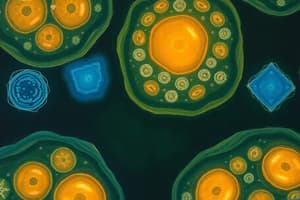Podcast
Questions and Answers
Which organelle is responsible for the synthesis of proteins in a cell?
Which organelle is responsible for the synthesis of proteins in a cell?
- Vacuole
- Endoplasmic reticulum (correct)
- Lysosome
- Golgi apparatus
Which structure is present in plant cells but not in animal cells?
Which structure is present in plant cells but not in animal cells?
- Lysosome
- Centriole
- Nucleolus
- Chloroplast (correct)
Which organelle is responsible for maintaining the cell's shape, providing mechanical support, and enabling cell movement?
Which organelle is responsible for maintaining the cell's shape, providing mechanical support, and enabling cell movement?
- Nucleolus
- Ribosome
- Vacuole
- Cytoskeleton (correct)
Which of the following is NOT a characteristic feature of bacteria, protists, and fungi?
Which of the following is NOT a characteristic feature of bacteria, protists, and fungi?
What is the primary function of the cell wall in bacteria, protists, and fungi?
What is the primary function of the cell wall in bacteria, protists, and fungi?
Which of the following accurately describes a beneficial role of bacteria, protists, or fungi?
Which of the following accurately describes a beneficial role of bacteria, protists, or fungi?
Which of the following accurately describes a unique structural feature of both bacteria and fungi?
Which of the following accurately describes a unique structural feature of both bacteria and fungi?
What is a common feature shared by protists and fungi but not present in bacteria?
What is a common feature shared by protists and fungi but not present in bacteria?
Which of the following statements accurately describes a beneficial role of bacteria, protists, or fungi?
Which of the following statements accurately describes a beneficial role of bacteria, protists, or fungi?
Flashcards
Protein synthesis organelle
Protein synthesis organelle
The Endoplasmic Reticulum is responsible for protein synthesis in a cell.
Plant cell unique organelle
Plant cell unique organelle
Chloroplasts are found in plant cells, but not animal cells.
Cell shape & movement structure
Cell shape & movement structure
The cytoskeleton maintains cell shape, provides support, and enables movement.
Feature NOT in bacteria, protists, fungi
Feature NOT in bacteria, protists, fungi
Signup and view all the flashcards
Cell wall function
Cell wall function
Signup and view all the flashcards
Beneficial bacteria/protist/fungi role
Beneficial bacteria/protist/fungi role
Signup and view all the flashcards
Bacteria and fungi reproduction
Bacteria and fungi reproduction
Signup and view all the flashcards
Protists and fungi shared feature
Protists and fungi shared feature
Signup and view all the flashcards
Bacteria, protist, fungi beneficial roles
Bacteria, protist, fungi beneficial roles
Signup and view all the flashcards
Study Notes
Cell Organelles
- The ribosome is responsible for the synthesis of proteins in a cell.
Plant Cells vs. Animal Cells
- A cell wall is present in plant cells but not in animal cells.
Cellular Functions
- The cytoskeleton is responsible for maintaining the cell's shape, providing mechanical support, and enabling cell movement.
Characteristics of Microorganisms
- The presence of a true nucleus is NOT a characteristic feature of bacteria, protists, and fungi.
Cell Wall Functions
- The primary function of the cell wall in bacteria, protists, and fungi is to provide structural support and maintain the cell's shape.
Beneficial Roles of Microorganisms
- One beneficial role of bacteria, protists, or fungi is to decompose organic matter and recycle nutrients.
Unique Structural Features
- A unique structural feature of both bacteria and fungi is the presence of a cell wall.
Common Features of Protists and Fungi
- A common feature shared by protists and fungi but not present in bacteria is the presence of a true nucleus.
Beneficial Roles of Microorganisms
- Another beneficial role of bacteria, protists, or fungi is to fix nitrogen and make it available to other organisms.
Studying That Suits You
Use AI to generate personalized quizzes and flashcards to suit your learning preferences.




